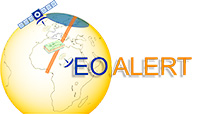EO-ALERT – EXTREME WEATHER SCENARIO: TOWARDS CONVECTIVE STORM NOWCASTING VIA ON-BOARD SATELLITE PROCESSING
A. Fiengo(1), C. Marcos(2), J. I. Bravo(1), M. Kerr(1)
1DEIMOS Space S.L.U., Tres Cantos – Madrid, Spain,
Email: {aniello.fiengo, juan-ignacio.bravo, murray.kerr}@deimos-space.com
2Agencia Estatal de Meteorología, Spain, Email: cmarcosm@aemet.es
ABSTRACT
Fast data availability plays a crucial role in nowcasting applications, where the value of data decreases with time since the moment of acquisition. In Earth Observation (EO) systems, data gathered from a satellite platform is subject to space-to-ground transmission, hence, presenting a relatively large latency between the event and the on-ground observation. The EO-ALERT H2020 project (see, http://eo-alert-h2020.eu/) aims to close this latency gap by implementing processing capabilities on-board the satellite rather than increasing transmission rates, with the goal of producing EO image products on-board that can be quickly and reliably transferred to ground given their relatively low data volume. Two scenarios are considered within the EO-ALERT project: ship detection and a meteorological scenario focused on storm detection in support to nowcasting; the latter will be the focus of this paper.
To achieve on-board storm detection in support to nowcasting, a combination of novel processing techniques and nowcasting domain expertise are being used to develop a data-driven system capable of detecting, tracking and classifying early convective storms on-board the satellite. The objective is to process the acquired data from the satellite payload observation directly on-board the satellite and then send the processed information (the EO product) to ground within 5-minutes of the observation, with a goal to reach latencies down to 1-minute. The system is designed to work on satellites in any orbit (LEO, MEO or GEO), such as upcoming LEO constellations or Meteosat Third Generation GEO satellites, using the satellite payload (imager) as the main source of onboard data. In the project, the proof of concept is performed using existing geostationary EO satellites, in the Meteosat Second Generation satellite. The solution will be calibrated and validated using a specifically created dataset for the application, corresponding to extreme convective weather events occurred over 85 days, composed of MSG images and OPERA weather-radar network composites.
This paper will provide an overview of the overall system, focusing on the algorithmic approaches and the open lines of research. Further advances and the results of the system testing in an satellite avionics test bench, will be presented in future publications, taking into account the feedback received at the conference.
© 2019 EO-ALERT All Rights Reserved

